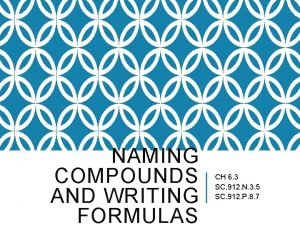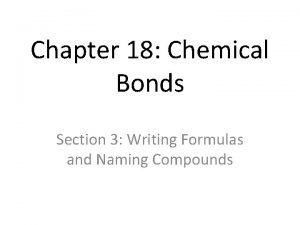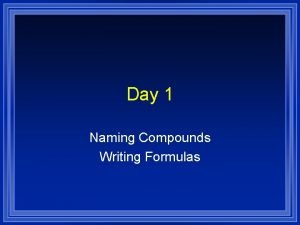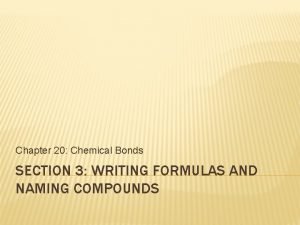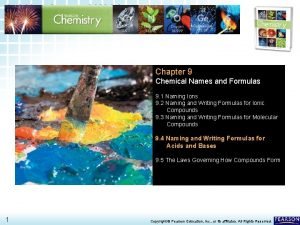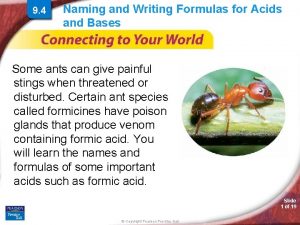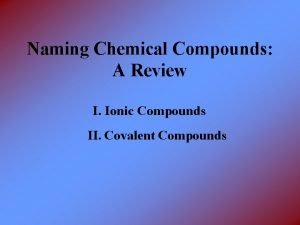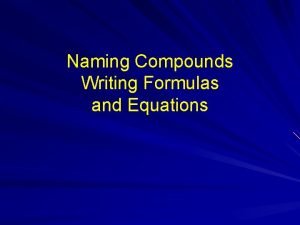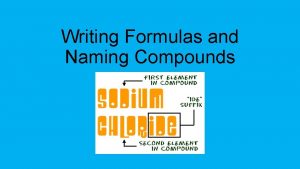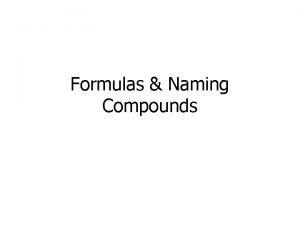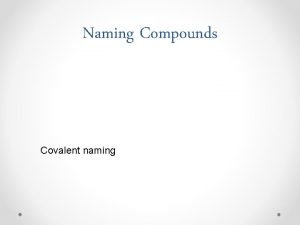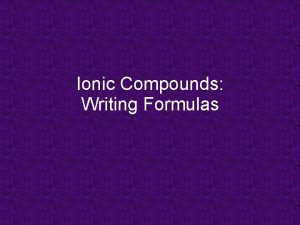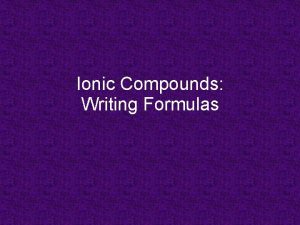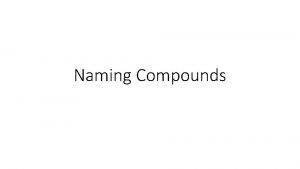Rules for Naming Compounds and Writing Formulas Naming








- Slides: 8

Rules for Naming Compounds and Writing Formulas

Naming Binary Ionic Compounds • Determine whether the element would lose or gain electrons when bonding to get a full outer energy level and determine the charge the ion would have resulting from losing or gaining electrons. (practice problems Ch 6 #2, 16 -17) • Positive ions are called cations and negative ions are called anions. (practice problems #18 -19) • Cations names are taken straight from the periodic table. For Anions names, the end of the name on the periodic table is replaced with “ide”. (practice problems #1, 8 -9, 2223) • When cations and anions come together to make a compound, the cation is always written first and capitalized and the anion is written second (practice problems #26 -27)

Writing Binary Ionic Compound Formulas • Determine the charge of each element in the compound (can use pgs 143 -144). • Make the charges equal zero by adding the correct number of atoms for each element. • Write the cation first and anion second. (practice problems 24 -25) Ex: Oxygen O 2 Na 2 O Sodium Na 1+

Naming Ternary Ionic Compounds • Use Polyatomic Ions, which are tightly bound groups of atoms that behave as a unit and carry a charge. • Most end in “ite” or “ate” and are listed in a table on pg 147. • Cations are written first and anions are written second just like binary ionic compounds. (practice problems 30 -31 and #12 in Ch 15)

Writing Ternary Ionic Compound Formulas • Follow the same rules as binary compounds except if you need more than one polyatomic atom. • Parentheses are used around polyatomic atoms when you need more than one to balance the charges. (Practice problem #28 -29 and #11 in Ch 15) Ex: Magnesium Mg 2+ Mg(NO 3)2 nitrate NO 31 -

Naming Molecular Compounds • Composed of molecules (covalent bonds), so ionic charges are not used to assign formulas or names to them. • When two non metallic compounds come together, they can form more than one compound. Ex: CO and CO 2 • Prefixes are therefore used to indicate these different compounds. Mono-1 Tetra-4 Hepta-7 Di-2 Penta-5 Octa-8 Tri-3 Hexa-6 Nona-9 Deca-10

Naming Acids • Acids are compounds that produce hydrogen ions when dissolved in water. • Acids are an anion connected to a hydrogen ion. • If it a monatomic anion, then you add “hydro” on the front, end it with “ic” and then add acid. Ex: HCl Hydrochloric acid • If it is a polyatomic anion that end with “ate”, change ending to “ic” and add acid. Ex: H 2 SO 4 Sulfuric acid. • If it is a polyatomic anion that ends with “ite”, change ending to “ous” and add acid. Ex: HNO 2 Nitrous acid

• Use flow charts on pg 161 and 162 to help you with naming and writing formulas
 Naming and writing formulas for molecular compounds
Naming and writing formulas for molecular compounds Prefixes for hydrates
Prefixes for hydrates Ionic compounds list
Ionic compounds list Naming compounds and writing formulas
Naming compounds and writing formulas Section 3 writing formulas and naming compounds
Section 3 writing formulas and naming compounds Naming and writing formulas for acids and bases
Naming and writing formulas for acids and bases Naming and writing formulas for acids and bases
Naming and writing formulas for acids and bases Prefixes for hydrates
Prefixes for hydrates Review naming chemical compounds
Review naming chemical compounds
